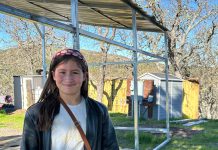Much is the same
– students at San Benito High School struggle with the exit
exam, administrators battle budget cuts and the campus is being
expanded for freshmen.
But much is different
– the student population at San Benito High School is 97 percent
Hispanic, some students attend the high school while attending a
college extension and the climate is a warm 80 degrees most of the
year.
Much is the same – students at San Benito High School struggle with the exit exam, administrators battle budget cuts and the campus is being expanded for freshmen.
But much is different – the student population at San Benito High School is 97 percent Hispanic, some students attend the high school while attending a college extension and the climate is a warm 80 degrees most of the year.
Although there are some similarities, it’s not exactly like looking in the mirror for students and staff at San Benito High School in Hollister.
The SBHS mentioned above can be found in the southern tip of Texas in the city of San Benito. Their mascot is the Greyhounds.
Dean of Instruction for the Texas SBHS, Alicia Torres, was surprised to hear there was another SBHS in California. San Benito’s population runs around 24,000 and the city is located in Cameron County with a population of 335,000.
SBHS is in the San Benito Consolidated Independent School District, with two middle schools, 10 elementaries and one alternative education campus.
With a school population of 1,650, one thing similar between both SBHSs is the need for more room on campus. Next school year, all the school’s freshmen will be housed on a separate campus.
While the high school only enrolls sophomores, juniors and seniors with a separate freshman academy, the academy is currently on the same campus.
“Eventually, we will need to construct a second high school,” Torres said. “But, the freshmen need their own separate campus. Once they leave, there will be more room around here.”
While the ninth-grade academy is not typical throughout Texas, the school district decided freshmen needed more of a transition between middle and high school. They “have a difficult transition,” Torres said.
Another difference between the two SBHS campuses is demographics. Because San Benito is 20 miles away from the Mexican border, around 97 percent of the students are Hispanic.
“We’re predominantly Hispanic. We’re so close to the border that it’s just predominant. We’re in the tip (of Texas),” Torres said.
Similar to California, Texas is experiencing budget cuts in education. Although the school’s budget was drastically cut, administrators have been successful in keeping cuts away from the classroom, Torres said.
“We had our budget slashed. We have half of what we had last year – that’s across the board (including other state agencies),” she said. “We’re doing fine. You have to make cuts in certain areas, but we didn’t cut core areas. We’ve made cuts within extracurricular activities, but we’re able to make do – we have to.”
Cuts were made in areas “we could live with,” Torres said, like travel and general supplies. Little or no staff were laid off in the district and instructional material funding remained in tact. To maintain staffing, employees were reorganized throughout the district.
Keeping funding cuts away from the classroom also meant maintaining low class sizes. While the Texas SBHS’s teacher-to-student ratio is 17-to-1, classroom size is at about 24.
“Obviously, our (Advanced Placement) classes are smaller, but out electives are pretty big,” Torres said. “Our maximum (class size) is set at 30. That’s just by necessity.”
Greyhound students can sympathize with Balers in terms of the California High School Exit Exam. High school seniors in Texas have to pass the TAKS, or the Texas Assessment of Knowledge and Skills, to graduate.
Because TAKS was implemented a decade ago, the test has progressed to assessing math, language arts, science and social studies, instead of just math and language arts like California’s. This is the first year all four subject areas will be tested.
“We’re going to struggle with the test this year, I foresee. The rigor has really shot up,” Torres said. All but three or four students there pass the test by the time they graduate each year.
Although the federal No Child Left Behind Act strikes anxiety into educators across the nation, Torres said SBHS is a little better off because both President Bush and U.S. Secretary of Education Rod Paige are from Texas.
Both took a lot of the same education ideas from Texas to the national level, she said.
Many Greyhound students benefit from state university satellite schools. Two universities – the University of Texas at Brownsville and UT Pan America in Edinburgh – are within 40 miles of SBHS, Torres said.
“We have a lot of students who take advantage of dual enrollment – they receive double credit for graduation and college,” Torres said.
The University of Texas has 10 satellite schools across the state. Many students who go to college attend a school within the University of Texas system.
In fact, if an SBHS student takes and passes four AP tests, UT Pan American will give them a full ride, Torres said.
“Few colleges do that. It’s a real incentive. We try to motivate our kids (to go to college) that way,” she said.
The Greyhounds have an active sports program. Football is big, as with every high school across Texas, Torres said
The school does not offer any swimming programs because they don’t have the facilities. Not having a pool is ironic in a city with an average yearly temperature in the 80s.
Right now, San Benito weather is cloudy and in the 40s.
“Our typical weather is in the 80s, even in the winter. This is cold for us,” Torres said. “But the kids love it – they can wear their letterman jackets.”









